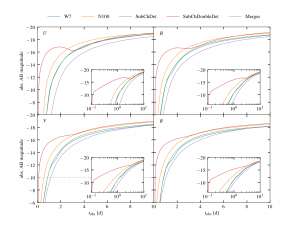Early light curves for Type Ia supernova explosion models

Upcoming high-cadence transient survey programmes will produce a wealth of observational data for Type Ia supernovae. These data sets will contain numerous events detected very early in their evolution, shortly after explosion. In a recent study, a team around Ulrich Nöbauer from the Max Planck Institute for Astrophysics, including PSO researcher Markus Kromer, used numerical simulations to calculate synthetic observables for a number of different explosion models, specifically focusing on the first few days after explosion. They show that overall the early light curve evolution is similar for most of the investigated models. Characteristic imprints are induced by radioactive material located close to the surface. However, these are very similar to the signatures expected from ejecta–CSM or ejecta–companion interaction. Apart from pure deflagration explosion models, none of the synthetic light curves exhibit the commonly assumed power-law rise. They demonstrate that this can lead to substantial errors in the determination of the time of explosion.
Publication: U. M. Noebauer, M. Kromer, S. Taubenberger, P. Baklanov, S. Blinnikov, E. Sorokina and W. Hillebrandt (2017): Early light curves for Type Ia supernova explosion models Monthly Notices of the Royal Astronomical Society, 472, 2787–2799.
This work was also featured as a research highlight at the Max Planck Institute for Astrophysics.
Über das HITS
Das HITS (Heidelberger Institut für Theoretische Studien) wurde 2010 von dem Physiker und SAP-Mitbegründer Klaus Tschira (1940-2015) und der Klaus Tschira Stiftung als privates, gemeinnütziges Forschungsinstitut gegründet. Es betreibt Grundlagenforschung in den Naturwissenschaften, der Mathematik und der Informatik. Zu den Hauptforschungsrichtungen zählen komplexe Simulationen auf verschiedenen Skalen, Datenwissenschaft und -analyse sowie die Entwicklung rechnergestützter Tools für die Forschung. Die Anwendungsfelder reichen von der Molekularbiologie bis zur Astrophysik. Ein wesentliches Merkmal des Instituts ist die Interdisziplinarität, die in zahlreichen gruppen- und disziplinübergreifenden Projekten umgesetzt wird. Die Grundfinanzierung des HITS wird von der Klaus Tschira Stiftung bereitgestellt.